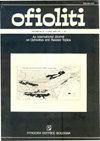阿曼北部玄武岩喷出岩上晚白垩世远洋沉积物的放射虫时代和岩石地层学
IF 1.3
4区 地球科学
Q2 GEOLOGY
引用次数: 4
摘要
报道了阿曼蛇绿岩玄武岩喷出熔岩上覆的远洋沉积物的详细放射虫生物地层学,该地层学适用于阿曼山脉北部Wadi Jizzi河附近Suhaylah组的类型位置。研究剖面中的喷出熔岩被归类为大洋中脊岩浆作用产生的V1熔岩。类型剖面中的沉积序列(约18 m厚)分为三个单元(按地层顺序):含金属沉积物(第一单元)、夹放射性燧石的红色泥岩(第二单元)和微晶灰岩(第三单元)。所有单元中保存完好的放射虫的回收导致了三个独特组合的识别:从红色泥岩中的含金属沉积物和燧石夹层中获得的组合A可能与中晚期Cenomanian动物群相关;根据与Cenomanian-Turonian边界放射虫产状的相关性,从红色泥岩和燧石中回收的B组分被归属于早期Turonian;C组,在微晶灰岩中发现,广泛认为是土仑-科尼亚阶。Suhaylah组的年龄先前被解释为早期Cenomanian至Coniacian Santonian;然而,修订后的年龄可能是从塞诺曼晚期到图伦-科尼亚期。估计的含金属沉积物的可能最大年龄(96.5-93.9Ma)与归因于山脊岩浆作用的蛇绿岩壳的高精度U-Pb锆石日期非常一致。远洋沉积物的沉积年龄清楚地表明,山脊岩浆作用在约95.5 Ma结束。本文章由计算机程序翻译,如有差异,请以英文原文为准。
RADIOLARIAN AGE AND LITHOSTRATIGRAPHY OF LATE CRETACEOUS PELAGIC SEDIMENTS OVERLYING BASALTIC EXTRUSIVE ROCKS, NORTHERN OMAN MOUNTAINS
A detailed radiolarian biostratigraphy of pelagic sediments overlying basaltic extrusive lavas of the Oman Ophiolite is reported for the type locality of the Suhaylah Formation near the Wadi Jizzi River, northern Oman Mountains. The extrusive lavas in the studied section are classified as V1 lava produced by mid-ocean-ridge magmatism. The sedimentary succession in the type section (ca. 18 m thick) is subdivided into three units (in stratigraphic order): metalliferous sediments (Unit 1), red mudstone intercalated with radiolarian chert (Unit 2), and micritic limestone (Unit 3). The recovery of well-preserved radiolarians from all units led to the recognition of three distinctive assemblages: Assemblage A, obtained from metalliferous sediments and chert intercalations within red mudstone, could be correlated with the middle-late Cenomanian fauna; Assemblage B, recovered from red mudstone and chert, is assigned to the early Turonian, based on correlation with radiolarian occurrences across the Cenomanian-Turonian boundary; Assemblage C, recognized in micritic limestone, is broadly identified as Turonian-Coniacian. The age of the Suhaylah Formation has previously been interpreted as early Cenomanian to Coniacian-Santonian; however, the revised age could be from late Cenomanian to Turonian-Coniacian. The estimated possible maximum age of metalliferous sediments (96.5-93.9 Ma) is in good agreement with high-precision U-Pb zircon dates of ophiolite crust attributed to ridge magmatism. The depositional age of the pelagic sediments clearly indicates that the ridge magmatism had ended by ca. 95.5 Ma.
求助全文
通过发布文献求助,成功后即可免费获取论文全文。
去求助
来源期刊

Ofioliti
地学-地质学
CiteScore
2.40
自引率
7.70%
发文量
1
期刊介绍:
Since 1976, Ofioliti provides an international forum for original contributions and reviews in the field of the geodynamics, petrology, geochemistry, biostratigraphy, stratigraphy, tectonics and paleogeography applied to ophiolitic terrains and modern oceanic lithosphere, including their sedimentary cover. Studies of topics such as geodynamics of the mantle, the evolution of orogens including ophiolites and paleoceanography are also welcome
 求助内容:
求助内容: 应助结果提醒方式:
应助结果提醒方式:


